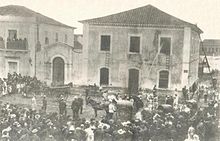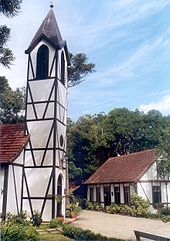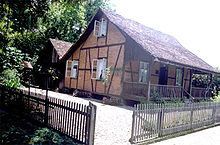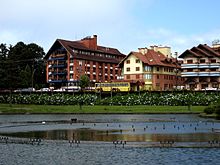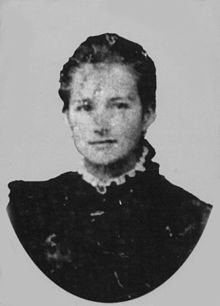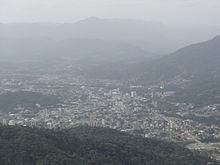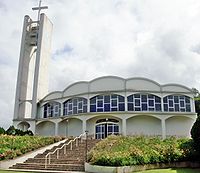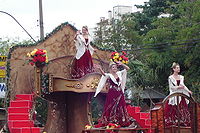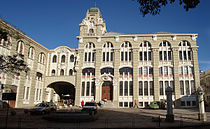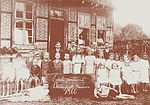- German Brazilian
-
German Brazilian
Germano-Brasileiro · Deutschbrasilianer








Vera Fischer[1] · Ernesto Geisel[2] · Gisele Bündchen[3]
Arthur Friedenreich[4] · Lya Luft[5] · Dunga[6]
Ana Hickmann · Oscar Niemeyer · Eike BatistaTotal population Unknown Regions with significant populations Southeast and Mainly Southern Brazil Languages Predominantly Portuguese. Minorities speak Brazilian German dialects
Religion Predominantly Catholic and Lutheran
Related ethnic groups White Brazilian, German people
A German Brazilian (German: Deutschbrasilianer, Portuguese: teuto-brasileiro or germano-brasileiro) is a Brazilian person of ethnic German ancestry or origin. Although there are German Brazilians in many parts of Brazil, they live mostly in the Southern part of the country, comprising the states of Rio Grande do Sul, Paraná, Santa Catarina and São Paulo.
Overview
The 19th century was marked by an intense emigration of Europeans to different parts of the world, which led to a process of Europeanisation of these areas. Between 1816 and 1850, 5 million people left Europe; between 1850 and 1880 another 22 million people emigrated. Between 1846 and 1932, 60 million Europeans emigrated. Many Germans left the German states after the failed revolutions of 1848. Between 1878 and 1892, another 7 million Germans left Germany; after the 1870s Germany was one of the countries from which the largest numbers of people emigrated, the vast majority to the United States. From 1820 to 1840, Germans represented 21.4% of all European immigrants entering the USA; 32.2% in the following two decades; and at the end of the century they were the largest immigrant group (21.9%) in the US.[7]
German immigration to Brazil was small compared to the numbers who went to the United States, and also compared to immigration of other nationalities, such as Portuguese, Italians and Spaniards, who together made up over 80% of the immigrants to Brazil during the period of greatest immigration by Europeans. Germans appeared in fourth place among immigrants to Brazil, but dropped to fifth place when Japanese immigration increased after 1908.[7]
Even though the immigration of Germans to Brazil was small, it had a notable impact on the ethnic composition of the country, particularly of the Southern Brazilian population. Different factors led to this large influence. First of all, German immigration to Brazil is an old phenomenon which started as early as 1824, many decades before the beginning of the immigration of other European ethnic groups to Brazil. For example, the first significant groups of Italians to immigrate to Brazil only arrived in 1875, many decades after the arrival of the first Germans. When the settlement of other Europeans in Brazil began, the Germans had already been living there for many generations. Another factor was the high birth rates among German Brazilians. Research has found that between 1826 and 1828 a first-generation German Brazilian woman had an average of 8.5 children, and the second generation had an average of 10.4 children per woman. Birth rates among German Brazilian women were higher than those of other Brazilian women, resulting in faster growth of the population of German origin than of the population of non-German origin and a rapid increase in the population of German origin in the country.[7]
In the book The Monroe Doctrine by T B Edgington is said:
The natural increase of the German population in southern Brazil is marvelous. As a rule they rear from ten to fifteen children in each family. Blumenau, a colony which was settled by the Germans over fifty years ago, more than doubles itself every ten years. Southern Brazil is now called ‘Greater Germany’, and the Germans exercise there a commercial and financial supremacy.
Even though the population of German descent makes up a small minority in Brazil, they represent a very large percentage of the population of the South. Jean Roche estimated that people of German descent made up 13.3% of the population in Rio Grande do Sul in 1890, and that they had increased to 21.6% of the population in 1950. By 1920, the vast majority of the population of German descent was Brazilian-born. The Census of 1920 revealed that foreigners constituted only 3% of the population of the old German communities of São Leopoldo, Estrela, Montenegro and Bom Retiro. São Leopoldo, then with 46,482 inhabitants, had only 1,159 foreigners. In the new German communities the proportion of foreigners was larger, for example in Ijuí (15%) and Erechim (25%), indicating they were newer destinations of immigrants in the state. The Census of 1940 revealed that virtually all the population of German descent was native-born.
The occupation of vast areas in Southern Brazil by people of German origin had a visible and important influence in the region. The descendants of German immigrants preserved their language and customs more than any other immigrant group in Brazil, creating a paradox of identity between German and Brazilian. In the Brazilian tradition, citizenship is inherent in the place of birth (Brazilians are all people born in Brazil). In the German tradition, citizenship is passed down to descendants (Germans are all people with German blood). Thus, Germans considered that a person could be legally a Brazilian citizen, but due to ancestry be still part of the German people. Thus, terms such as fatherland, (Vaterland), mother country (Mutterland), homeland (Heimat), guest country (Gastland) and several others came to be used by a few German Brazilians, denoting the contrast between being a Brazilian citizen and still having the feeling of belonging to the German people. This led to the creation of some Germanism (Deutschtum) in Brazil, influenced by Pan-Germanism.[7]
Only a minority of German Brazilians were Germanists. Most German Brazilians did not consider it important to be connected to Germany through associations or political parties. Despite attempts by Germanists to attract the population of German origin in churches or schools, few of them followed these ideas. This was evident in the failure of the Nazi Party when trying to attract a following among German Brazilians. The 1920s were the decade of peak German immigration to Brazil, some 75,000 people (24,000 in 1924 alone). They were fleeing the consequences of World War I and, therefore, it was considered a transitory immigration. Joining the Nazi Party would give them an advantage if they returned to Germany. However, very few German Brazilians were interested: fewer than 5,000 joined, out of a population at that time of about 100,000 German immigrants and nearly 1 million German descendants. This shows that the connection between German Brazilians and Germany was not as strong as believed. The connection was mostly focused on language and culture, while racist ideas and so-called German racial superiority had few adherents among German Brazilians, although there are reports that a minority did hold such views. German Brazilians were not completely unified in their political ideology; research shows that they voted for a variety of candidates in elections. There was no "vote from the Germans", but different ideas within the community.[7]
The idea of a perigo alemão ("German threat") emerged in Brazil in the late 19th century, the fear of what a “confederacy of German Brazilians” could mean for Brazil and its integration. In fact, that fear seems to have been exaggerated given that German Brazilians did not form a united group and most of them seemed not to be interested in getting involved in political issues (given the failure of the Nazi Party in Brazil) or in racist or separatist groups that could represent a real problem for Brazil. Nonetheless, the conservation of the German language among German Brazilians, the isolation of the population in rural areas in Southern Brazil and the small but notorious number of people who were seduced by Germanist ideas seemed to be a problem in the eyes of the Brazilian Government. As a result, policies were implemented to force these people to assimilate. Both the Germanism followed by a few Germans in Brazil and the assimilationist ideology of the Brazilian government were racist. The first was based on the idea of the superiority of the German people, and that they should keep themselves separate from other ethnic groups. The second was based on the idea that whites should mix with non-whites, in order to cause a whitening of the Brazilian population that would culminate in the disappearance of the “inferior non-white races”. The Brazilian process of forced assimilation, like any other aggressive policy against immigrants, brought more problems than solutions, but it weakened the learning of the German language. In the following decades, many of the German Brazilians left the isolated areas where they used to live and migrated to urban centers. Like other immigrants in the Brazilian cities, they found themselves in the minority there and as a consequence adopted Portuguese instead of German and their sense of German identity, already weakened due to the forced assimilation of the past decades, was replaced by a Brazilian identity shared with Brazilians from other ethnic backgrounds.[7]
Immigration
When German-speaking immigrants first arrived in Brazil starting at the beginning of the 19th century, they did not identify themselves so much as a unified German-Brazilian group. However, as time went on this common regional identity did emerge for many different geo-socio-political reasons. Germans immigrated mainly from what is now Germany, but also from other countries where German communities were established. From 1824 to 1969, around 250,000 Germans emigrated to Brazil, being the fourth largest immigrant community to settle in the country, after the Portuguese, Italians and Spaniards. About 30% of them arrived between World War I and World War II.
German immigration to Brazil, decennial periods from 1824 to 1969
Source: Brazilian Institute for Geography and Statistics (IBGE)Decade Nationality 1824–47 1848–72 1872–79 1880–89 1890–99 1900–09 1910–19 1920–29 1930–39 1940–49 1950–59 1960–69 Germans 8,176 19,523 14,325 18,901 17,084 13,848 25,902 75,801 27,497 6,807 16,643 5,659 First German settlement in Brazil
The first German immigrants to settle in Brazil were 165 families who settled in Ilhéus, Bahia, in 1818. One year later, 200 families settled São Jorge, in the same state. Some Germans were brought to work in the Brazilian army after Independence from Portugal in 1822.[8]
However, the cradle of the German settlement in Brazil was São Leopoldo, in 1824. At that time Southern Brazil had a very low population density. Most of its inhabitants were concentrated on the coast and a few in the Pampas. The interior was covered by forests and populated by Indians. This lack of population was a problem, because Southern Brazil could easily be invaded by neighboring countries.
Since Brazil was recently independent from Portugal, it was not possible to bring Portuguese immigrants. Germany was suffering the effects of the wars against Napoleon, overpopulation and poverty in the countryside. Many Germans were willing to immigrate to Brazil. Furthermore, Brazil's Empress, Maria Leopoldina, was Austrian and encouraged the arrival of German immigrants.
The first communities
Major Schaeffer, a German who was living in Brazil, was sent to Germany in order to bring immigrants. He brought immigrants and soldiers from Rhineland-Palatinate. To attract the immigrants, the Brazilian government had promised large tracts of land where they could settle with their families and colonize the region. In fact, these lands were in the middle of big forests and the first Germans had been abandoned by the Brazilian government. From 1824 to 1829, the Major brought 5,000 Germans to Brazil.[9]
German immigrants in Brazil settled mostly in rural areas, called colonies (colônias in Portuguese). These colonies were created by the Brazilian government, and the lands were distributed among the immigrants. They had to construct their own houses and cultivate the land.
The first years were not easy. Many Germans died of tropical disease, while others left the colonies to find better living conditions. The German colony of São Leopoldo was a disaster. Nevertheless, in the following years, a further 4,830 Germans arrived at São Leopoldo, and then the colony started to develop, with the immigrants establishing the town of Novo Hamburgo (New Hamburg). From São Leopoldo and Novo Hamburgo, the German immigrants spread into other areas of Rio Grande do Sul, mainly close to sources of rivers. The whole region of Vale dos Sinos was populated by Germans. During the 1830s and part of the 1840s German immigration to Brazil was interrupted due to conflicts in the country (War of the Farrapos).
First Settlers in Joinville [10] Origin Immigrants Switzerland 190 Prussia 70 Norway 61 Oldenburg 44 Holstein 20 Hannover 20 Sleswig 17 Hamburg 16 Saxony 8 Poland 5 Lübeck 4 Mecklenburg 4 Luxembourg 3 Sweden 3 Wurtemberg 1 Brunsvick 1 Schwarzburg 1 Others 4 Waves of immigrants
Immigration restarted after 1845 with the creation of new colonies. The most important ones were Blumenau in 1850 and Joinville in 1851, both in Santa Catarina state; these attracted thousands of German immigrants to the region. Some of the mass influx was due to the Revolutions of 1848 in the German states. Nowadays these areas of German colonization are among the wealthiest parts of Brazil, with the lowest levels of unemployment[citation needed] and illiteracy[citation needed] found in the country, and still retain a strong influence from German culture.
By the end of the 19th century, 122 German communities had been created in Rio Grande do Sul, and many others in Santa Catarina, Paraná, São Paulo, Minas Gerais and Rio de Janeiro. Germans helped to establish a middle-class population in Brazil, a country that was formerly divided between slaves and their masters.[11]
-
- Nowhere are our colonies, those loyal offshoots from the mother root, so promising as here. Today in these provinces, over thirty per cent of the inhabitants are Germans, or of German descent, and the ratio of their natural increase far exceeds that of the Portuguese. Surely to us belongs this part of the world, and the key to it all is Santa Catharina, stretching from the harbor of San Francisco far into the interior with its hitherto undeveloped, hardly suspected wealth. Here indeed, in southern Brazil, is a rich and healthy land, where the German emigrant may retain his nationality, where for all that is comprised in the word ' Germanismus,' a glorious future miles.
-
-
-
-
-
-
-
-
-
-
-
-
-
-
-
-
-
-
-
-
-
- - Dr. Leyser, a German traveller in South Brazil at the beginning of XX´s century. [5]
-
-
-
-
-
-
-
-
-
-
-
-
-
-
-
-
-
-
-
-
-
- Nowhere are our colonies, those loyal offshoots from the mother root, so promising as here. Today in these provinces, over thirty per cent of the inhabitants are Germans, or of German descent, and the ratio of their natural increase far exceeds that of the Portuguese. Surely to us belongs this part of the world, and the key to it all is Santa Catharina, stretching from the harbor of San Francisco far into the interior with its hitherto undeveloped, hardly suspected wealth. Here indeed, in southern Brazil, is a rich and healthy land, where the German emigrant may retain his nationality, where for all that is comprised in the word ' Germanismus,' a glorious future miles.
Urban Germans in Brazil
Not all Germans who settled in Brazil became farmers. In the early 20th century, very few rural areas of Southern Brazil were empty. Most of them had been settled by German, Italian and Polish immigrants during the 19th century. Given this situation, most Germans who immigrated to Brazil during the 20th century settled in big towns, although many of them also settled in the old rural German colonies. German immigration to Brazil peaked during the 1920s, after World War I. These Germans were mostly middle-class laborers from urban areas of Germany, different from the poor peasants who had settled in the colonies of Brazil during the 19th century.
In 1858, Germans were 15% of Porto Alegre´s population,[12] 10% of São Paulo´s population for 1860 [13] and 60% of immigrants living in Curitiba by the end of XIX century.[14] In Rio de Janeiro, by 1830 there were 20 businesses owned by Germans. Twenty years later the number reached 50. [15]
 Many cities in Porto Alegre´s Metropolitan Area was founded by Germans, such as São Leopoldo, Novo Hamburgo, Nova Hartz, Dois Irmãos(Baumschneis), Ivoti(Berghanschneis) and Sapiranga(Leoner-Hof).
Many cities in Porto Alegre´s Metropolitan Area was founded by Germans, such as São Leopoldo, Novo Hamburgo, Nova Hartz, Dois Irmãos(Baumschneis), Ivoti(Berghanschneis) and Sapiranga(Leoner-Hof).
People of German descent actively participated in the industrialization and development of big cities in Brazil, such as Curitiba and Porto Alegre.
In São Paulo, Germans founded their first colony in 1829. The city attracted Germans immigrants until the 1950s. Today, there are 400.000 German Brazilians living within Greater São Paulo.[16][17]
Owners of Industrial and Commercial Establishments in Curitiba (1869-1889)[18] Ethnic origin Total Brazilians 230 Germans 104 Italians 26 French 18 English 8 The pioneering period
The German settlements, and also those of other European ethnic groups, occupy a vast area in the centers of the states of Paraná, Santa Catarina and Rio Grande do Sul. To the east, they border the old areas of Azorean Portuguese colonization, and to the south and west, the Gaucho grazing areas. The areas of German settlement emerged in the center of the region, isolated from other settlements. In these remote pastoral and farming areas, the immigrants were not under the control of the powerful Brazilian landowners. Due to this isolation, the immigrants were able to organize themselves independently, building their own churches, schools and municipal authorities. The children were educated in German. Portuguese became dominant later, as a means of communication with Brazilians or with immigrants of other nationalities.[19]
The first generation of immigrants faced the arduous task of surviving while opening gaps in the virgin forest to build their own houses and roads. Attacks by Indians were common. Isolated from other settlements, the Germans also had to face the difficulty of finding markets for their products. The initial difficulty was to define which productive activities could be integrated into the Brazilian economy. Only the penury faced by these people in Europe, due to the consequences of the Industrial Revolution and of the crisis during the consolidation of European nations, can explain their persistence in Brazil, sometimes facing miserable conditions which were worse than those they left in Europe. Once in Brazil, however, they became small landowners, which facilitated their development.[19]
Farms owned by an foreign(1920) Immigrants Farms [20] Italians 35.984 Portuguese 9.552 Germans 6.887 Spanish 4.725 Russians 4.471 Austrians 4.292 Japanese 1.167 The period of prosperity
The following generations benefited from the efforts of the pioneer immigrants and prospered. The families grew and the settlements expanded, coming to constitute a thriving German community of small landowners. At first, they found virgin forests that could be occupied or bought at low prices. During this period, the more isolated communities suffered from messianic anomie, influenced by popular German traditions of Protestant aspirations. This led to the Revolt of the Muckers in the 1870s, which culminated in several crimes and murders.[19]
Identity
According to Darcy Ribeiro, despite their isolation, the descendants of Germans knew that Brazil was their home now. The new immigrants who arrived from Germany were clearly different from German Brazilians of older stock. German Brazilians had moved away from European standards, habits, language and aspirations. However, coexistence with the local Brazilians (Indians, Gauchos and Azoreans) showed that the differences with the locals were also great. The misery faced by Brazilians of other origins was also not attractive to German Brazilians. Hence, German Brazilians eventually created a third identity, which was not completely German (because of the distance that created sharp differences) but also not completely Brazilian (because of the undesirable misery seen in Brazilians). Their isolation and cultural and linguistic conservatism gave rise to conflicts between German Brazilians (and also Japanese Brazilians, Italian Brazilians, etc.) on one side, and Brazilians of older extraction on the other. The nationalization was fundamental, compelling the teaching of foreign languages at schools, breaking the isolation of the communities and recruiting young people of foreign origins to serve in the military.
Migrating to urban centers, the younger generations broadened their cultural horizon and their own vision of Brazil. When they returned to their hometowns, they endorsed a Brazilian identity which was already becoming imperative. The above-average social, economic and cultural progress of the German settlements and their simultaneous integration into Brazilian markets as producers and consumers facilitated the integration of the descendants of Germans in Brazil. Today, this population is no longer seen as "foreign" by other Brazilians, but as a modern progressive urban population. The identification as "Brazilians" is also dominant among German Brazilians, since the cultural world of their ancestors was completely changed; it has become unrealistic for them to assert any other ethnic identity than Brazilian. Today[citation needed], the only notable differences between Brazilians of German and of non-German ancestry are in levels of education (higher among German Brazilians), in a few surviving German traditions,[19] and in some cases, the phenotype.
Panorama of German communities
The German Brazilian areas form, today, a Brazilian region with its own character, made up of towns and large concentrations of residents around the church, commerce and school. These rural villages are connected to major cities where the economy was diversified, adding cottage industries to the original agricultural production. In this way, the Southern Brazilian areas of European settlements formed a prosperous regional economy and a European cultural landscape, contrasting with the relative Portuguese-Brazilian uniformity found in the rest of Brazil. In recent years a large industrial development has occurred in these areas, stemming from the cottage industry. Some of the old German communities are now prosperous industrial centers, such as São Leopoldo, Novo Hamburgo, Blumenau, Joinville and Itajaí. The Germans became entrepreneurs due to their knowledge of more complex techniques of production than those dominated by other Brazilians. In addition their bilingualism gave them better European contacts.[19]
By 2002 City Hall research concluded that 45% of the people from Jaraguá do Sul descended from Germans. The other main groups were Italians (25%), Poles (6%), and Hungarians (3%); 21% had other ancestry. [21]
.
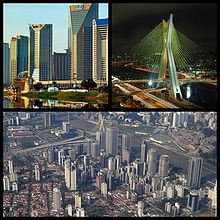 The Brooklin neighborhood was founded and populated by Germans. It was named after the New Yorker borough in 1906 by a Canadian company. [22]
The Brooklin neighborhood was founded and populated by Germans. It was named after the New Yorker borough in 1906 by a Canadian company. [22]
.
City Population(2010) State [23] Joinville 515.288 Santa Catarina Blumenau 309.011 Santa Catarina Petrópolis 296.044 Rio de Janeiro Novo Hamburgo 239.051 Rio Grande do Sul São Leopoldo 214.210 Rio Grande do Sul Nova Friburgo 182.016 Rio de Janeiro Itajaí 172.081 Santa Catarina Jaraguá do Sul 143.123 Santa Catarina Santa Cruz do Sul 118.287 Rio Grande do Sul Brusque 105.503 Santa Catarina German Brazilians State 1872[10] 1890[24] 1920[10] 1940 [25] 1950[24] Santa Catarina 7% 20,5% 22,34% Rio Grande do Sul 13,3% 19,3% 21,6% Paraná 6,9% São Paulo 2,5% German Brazilians in Espírito Santo [26] Year Population 1960 73.000 1980 145.000 2004 250.000 Ethnic Groups in Blumenau - Last decade of the 19th century [27] Origin Percentage Germans 70% Italians 15% Others 15% End of expansion
If in the beginning Germans found a region with vast empty areas, later with the compulsory occupation of the lands, the German expansion came to an end. As they expanded, the German settlements encountered the pastoral areas of the Gaúchos to the west and south. The Gaúcho area was an impoverished region consisting of huge farms, dominated by a small elite of landowners who monopolized the lands and a mass of underemployed people who worked for them in poor conditions, similar to the rest of Brazil and very different from the areas of German settlements, where each family had their own small farm. Due to the expansion of German and other European settlements in Southern Brazil, the lands for each family became limited because there was no more land available. Plots of land previously settled by a single family started to be occupied by two or four families. Without their own land, some descendants of Germans regressed to a situation of poverty, mingling with the mass of Gaúchos and descendants of Azorean Portuguese who make up the poor in Southern Brazil, in search of land to work.[19]
Culture
Language
The use of the German language is in decline in Brazil. However, the existence of important German-speaking communities in Brazil, even almost 200 years after the beginning of immigration, is an interesting fact. According to Born and Dickgiesser (1989, p. 55) the number of Brazilians of German descent in 1986 was 3.6 million. For Rio Grande do Sul, based on data from Birsa (Bilingualism in Rio Grande do Sul), for 1970, Altenhofen (1996, p. 56) estimated at 1,386,945 the number of speakers of a variety of German. As of 1996, he estimated that it had dropped to between 700,000 and 900,000 speakers. Damke (1997, p. 59), as of 1996, estimated more than 2 million speakers of any variety of the German language in Brazil.[28]
Country German speaking population (outside Europe)[29] USA 5,000,000 Brazil 3,000,000 Argentina 500,000 Canada 450,000[29] – 620,000[30] Australia 110,000 South Africa 75,000 (German expatriate citizens alone)[29] Chile 40,000 Paraguay 30,000 – 40,000 Namibia 30,000 (German expatriate citizens alone)[29] Mexico 10,000 Venezuela 10,000 German immigrants preserved their language more than any other group of immigrants in Brazil. This was mainly due to shared cultural identity and the desire to recreate in Brazil an environment with characteristics of the country they believed they would never return to. In addition, the large differences between the German and Portuguese languages hindered learning of the national language of Brazil, which was and remains a pretext for continuing use of German dialects. (This may be contrasted to the United States, where a huge German population almost completely switched to English, while on the other hand, Italian persisted longer than in Brazil.) The main German dialect spoken in Brazil is Hunsrückisch, and according to Ammon, who visited German-speaking communities in Southern Brazil in 2004, the Riograndenser Hunsrückisch (Brazilian Hunsrückisch) lexicon is still quite similar to that of modern German speakers, even after almost 200 years of distance.[28]
Hamel (1988, p. 64) and Damke (1997, p. 60-61) observed that there is a balance between the use of German and Portuguese in the German-speaking communities of Brazil. But, gradually, the trend is that Portuguese is becoming dominant. Despite the "myth of monolingualism in the country", i.e., that all Brazilians speak only Portuguese, German continues to have a strong presence even today. This myth is effective in hiding the country's linguistic minorities, including the indigenous nations and as well as the speakers of immigrant languages. But it also hides the majority of the Brazilian population that speaks discredited varieties of Portuguese instead of the formal standard Portuguese taught in schools.[28] According to Oliveira (2000: 84), Brazil is one of the most multilingual countries in the world, with inhabitants speaking around 200 languages, of which about 170 are indigenous and 30 languages of immigrants.[31]
The Brazilian Census of 1940 revealed that German was the second most spoken language in Brazil, with 644,458 speakers. In a total population of nearly 1 million German Brazilians at that time, over half still spoke German as their mother tongue. The vast majority of the German speakers were Brazilian-born, with a minority born in Germany or in another German-speaking country. The other main languages spoken were Italian with 458,054, Japanese with 192,698 and Spanish with 74,381.
People who usually do not speak Portuguese at home, by gender and nationality, according to the 1940 Brazilian Census[32] German speakers Men Women Brazilian born Naturalized Brazilians Foreigners 644,458 327,443 317,015 580,114 5,083 59,169 Discrimination
The "myth of monolingualism", along with the general idea that speaking Portuguese was a "condition to be Brazilian", has masked the presence of minority languages and contributed to ideas that German Brazilians were self-absorbed, separatist, thought themselves superior, and did not want to learn Portuguese. However, these beliefs did not take into account that the German communities in Brazil were formed in places isolated by forests, where the Portuguese-speaking population was not present, and it was natural that the children continue speaking German rather than adopt the Portuguese language with which they rarely had contact. The fact that they spoke German did not prevent them from seeing themselves as Brazilians, since they saw themselves as "Brazilians of German culture". Under Getúlio Vargas's government, during World War II, when Brazil broke off diplomatic relations with Germany (and also with the other Axis Powers, Italy and Japan), the use of the German language was repressed: teaching German in schools and publication of German newspapers were forbidden (together with Italian and Japanese).[31]
In this context, monolingualism appeared to solve the problems of learning Portuguese, and the language of immigrants was regarded as responsible for school failure and difficulties in learning Portuguese. In 1989 there was a controversy regarding German speakers in Brazil when the mayor of Santa Maria do Herval, a town in Rio Grande do Sul, issued a verbal orientation to the municipality's elementary teachers to retain students using Hunsrückisch during break time to "teach them Portuguese". Disagreement ensued, with some decrying the initiative as repressive, and others (including people of German descent) supporting the mayor on the basis that not being able to speak Portuguese is a handicap in Brazilian society. The guideline has since been overturned.
Religion
Most German-Brazilians are Roman Catholics or Lutherans (Evangelical Lutheran Church of Brazil). As with other Brazilians, there is a significant minority of non-religious people, and Pentecostalism is on the rise. Almost 85%[33] of all Lutherans in Latin America and the Caribbean live in Brazil.
Country Lutherans in America [33]  United States
United States7,504,244  Brazil
Brazil951,466  Canada
Canada232,904  Argentina
Argentina71,960  Bolivia
Bolivia24,400 Forced assimilation
-
- We most desire that at any cost a German country containing some 20 to 30 million Germans may grow in the twentieth century in Brazil, and that, no matter whether it remains a portion of Brazil or becomes a self-containing state or enters into close relations with our empire.
-
-
-
-
-
-
-
-
-
-
-
-
- - Gustav von Schmoller , German economist(1900).[6][7]
-
-
-
-
-
-
-
-
-
-
-
-
- We most desire that at any cost a German country containing some 20 to 30 million Germans may grow in the twentieth century in Brazil, and that, no matter whether it remains a portion of Brazil or becomes a self-containing state or enters into close relations with our empire.
When Germans first arrived in Southern Brazil in 1824, they found a country with a climate, vegetation and culture very different from those of Germany. Southern Brazil was a land of gauchos, cattle herders who lived, and still live, in the Pampas region of the Southern Cone. In the following decades, however, waves of German-speaking immigrants arrived, to the point that in many areas of Southern Brazil the vast majority of the inhabitants were Germans and even after three or four generations born in Brazil, these people used to consider themselves Germans.
Between 1937 and 1945 a significant portion of the Brazilian population suffered interference in daily life produced by a "campaign of nationalization". This population - called "alien" by the Brazilian government - was composed of immigrants and their descendants. Both the Brazilian Empire and the early Republic allowed groups of immigrants to settle in isolated communities, mainly in Southern Brazil, and to some extent in other parts, such as Espírito Santo, in the Southeast. These people had not been assimilated into the majority Brazilian society, a fact that worried the government of President Getúlio Vargas. The army had an important role during this process of forced assimilation of these areas of "foreign colonization" that created so-called "ethnic cysts" in Brazil. German Brazilians saw themselves as part of a pluralist society, so that the Deutschtum conception (of being part of a community with a shared German ancestry) seemed compatible with the fact that they were also Brazilian citizens. However, the Brazilian government only accepted the idea of the jus soli, so that all people born in Brazil should see themselves as Brazilians, and leave other ethnic associations behind. The Brazilian view contrasted with the jus sanguinis conception of most German Brazilians of that time, who were still connected to the ancestral homeland.[35]
Not only the people of German origin were considered "alien": almost all descendants of immigrants, in some degree, were "non-assimilated", in the opinion of Bethlem and other participants in the campaign. However, evidence of greater resistance to abrasileiramento (Brazilianization) was found in those areas considered "redoubts of Germanism", a situation considered risky to the cultural, racial and territorial integrity of the nation. One of the areas considered "non-patriotic" was the Vale do Itajaí, where the population was composed mostly of Germans, Italians and Poles. In the 1930s, the Vale do Itajaí was described as a place of "strange costumes, full of non-national Brazilians, contaminated by ideals of a nation that collapsed Brazil, a place of disintegration of national spirit". During this period of nationalization, the Germans were considered the most "alien", the Italians closest to the Brazilians, and the Poles in an intermediary position, but none of them were seen as unequivocally Brazilian.[36] The fear of secession was not a novelty in regard to the definition of the Brazilian nation-state: long before 1939, Brazilian nationalists feared the collapse of the South, considering it "too Germanized". Many members of the Brazilian army participated during this process, such as Nogueira:
“ As we can see, the German colonization has deep roots, has developed across the south of Brazil and would have terrifying aspects if the appropriate measures were not adopted, aimed at defending the interests of the sacred homeland and cut any and all possibility of disintegration of our territory" (Nogueira 1947:18).[37] ” Nogueira also compared the German Brazilians to "an octopus extending its tentacles" in Southern Brazil. Nogueira used the image of the occupation of the most fertile areas of southern territory by foreigners, who had no intention of being integrated into the country, but had remained segregated since the beginning of their settlement. The record of the first impressions about the city of Blumenau in his book received the subtitle of "One Weird City", arguing that "the German language is spoken without constraints, including in public offices". Silvio Romero (1906) compared German immigration to the Barbarian Invasions which brought about the end of the Roman Empire. Writings by different authors against the German settlement in Brazil displayed clear xenophobia against the so-called "German threat". The Portuguese language was presented as a fundamental criterion of nationality and this justified the nationalization of education and the closing of ethnic schools. Most German Brazilians could barely speak Portuguese, and when German was prohibited in the country, they faced many difficulties due to this language barrier.
From this perspective, the human element representative of the "more legitimate" national formation had the task of conforming immigrants and their descendants to the myth of the amalgam of the three races that makes up the Brazilian nation (whites, blacks and Indians).
In the 1930s, Brazil was home to one of the largest German populations outside Germany, with 100,000 German-born people and a community of 1 million people of German descent, whose ancestors had been settling the country since 1824.[38] Brazil also had the largest number of members of the Nazi Party outside of Germany, with 2,822 members.[39] The large number of people with German roots and a notable number of Nazi members were used by the Brazilian government to justify their programs of nationalization. During World War II, in 1942, Nazi Germany attacked Brazilian ships and Brazil declared war against Germany. President Getúlio Vargas initiated a strict program of forced cultural assimilation - Nacionalismo- that worked quite efficiently, if not initially. He forbade any organised manifestation of German culture in Brazil. Schools were required to teach exclusively in Portuguese,[40] and the publishing of books, newspapers and magazines in foreign languages (which in practice meant German language and Italian language) was subjected to prior censorship by the Ministry of Justice[41] The use of foreign languages in governmental precincts was forbidden,[42] as well as the use of foreign languages in religious services.[43] Members of the Brazilian army were sent to areas of "foreign colonization" to "monitor" the local population. There are records of arrest or moral coercion motivated by the use of foreign languages.[44][45]
The Nazi issue


Children make the Nazi salute in Presidente Bernardes, São Paulo (circa 1935) These problems were aggravated with the rise of Nazism in Germany. The Nazi Party soon took to the task of organizing abroad, wherever significant populations of German origin were present. In Brazil the results were not as the party expected. About 3,000 people joined it,[46] making the Brazilian section the numerically most important foreign branch of the Nazi Party; however, the considerable population of German origin in Brazil may have been more a problem than an asset for the German Nazi Party:[47] if on the one hand it raised the hope of interfering in Brazilian internal politics, on the other hand there was a concern not to alienate the Brazilian government, which Germany at the time hoped could be brought to its side, or at least remain in a benevolent neutrality.
In addition there was the issue of the local Brazilian Fascist-like Party, the Brazilian Integralist Action. In contrast to the Nazi Party, the Integralists favoured miscegenation, which they thought was essential to Brazilian national identity; this directly conflicted with the Nazi ideology of racial purity.[48] This was a problem, since the Integralists were able to attract some membership among Brazilians of German ancestry, thus competing with the Nazi organisation; moreover, until 1937, when Vargas imposed a dictatorship, the Integralists, unlike the Nazi Party, were able to participate in elections, and so there was a natural tendency of informal Nazi support for the Integralists.
Support for the Nazi regime in Germany was widespread among Brazilians of German descent, which certainly worried the Brazilian authorities. The racial and nationalist views of the Nazis easily blended into the Deutschtum ideology. However, the Nazis weren't able to capitalise this into a really strong membership, and their local actions, such as proposed boycotts, were resisted by most of the population of German ancestry.[47]
In fact, the fears of the Brazilian authorities regarding the expansion of Nazism in Brazil seem exaggerated in retrospect;[47] however, it should be taken into consideration that in 1938 Germany annexed Austria, and in 1939 it dismembered, then also annexed Czechoslovakia, and that the local sections of the Nazi Party were fully involved in these actions; manipulation of German minorities also played an important role in the internal politics of Poland (Danzig) and Lithuania (Memel). So, while exaggerated, the Brazilian government's worries seem to a certain extent justifiable.
In April 1938, Vargas outlawed the Nazi Party in Brazil (interestingly, the Brazilian parties themselves were outlawed in December 1937).[49] However, in December 1937 the Nazi German Ambassador to Rio de Janeiro, Karl Ritter, was already reporting nationalising actions by the Brazilian government. At that moment, conditions were being imposed for the continued functioning of German schools. Ritter had a problem in that his powers as Ambassador did not enable him to interfere on behalf of Brazilian citizens of German origin. However, in February 1938 Ritter met Vargas, and demanded criticism of Germany and Nazism in the Brazilian press be gagged.[49] As confirmed by diplomatic documents later declassified, the interest of the Embassy was in the Reichsdeutschen, or German citizens, not the Deutschbrasilianer, or Brazilian citizens of German ancestry.
In April, Vargas forbade any political activity by foreigners; in May, the Integralists attempted a coup against Vargas, which further complicated relations between Brazil and Germany.[49] Up to this moment, however, no actions were taken against cultural, religious or sports associations. Measures were intensified in 1939, when the public use of foreign languages was forbidden, including in elementary schools and religious ceremonies (harsh as this is, it is necessary to remember, as René Gertz points out, that about half of Lutheran ministers in Rio Grande do Sul were affiliated with the Nazi Party). The cultural associations had to stop promoting foreign cultures. In 1942, when Brazil entered World War II, further restrictions were put in place, and their enforcement was made stricter. No effort was made to suppress the Lutheran church; the teaching of foreign languages, including German, in high schools and colleges continued,[50] as well as their private use. Publicly speaking foreign languages, including German, was banned under penalty of imprisonment; this was especially enforced against the public use of German. Stores owned by Germans were ransacked. Establishments registered in foreign names had to be changed and worship in churches had to be only in Portuguese. During World War II, the Brazilian Expeditionary Force (FEB) enlisted many Germans and people of German descent to fight alongside the Allied forces, which was tragic for many of them, considering that the soldiers were forced to fight against Germany.[51]
There were differences in emphasis during the nationalization campaign; in particular, the interventor (unelected governor) of Rio Grande do Sul, Cordeiro de Farias, was notable for his harshness. At the time of Brazil's declaration of war against Germany, popular riots against citizens of German origin erupted in Rio Grande do Sul, as a response to the brutal sinking of Brazilian merchant ships by German U-boats that resulted in more than 600 deaths. When the Army repressed those riots and ensured the physical integrity of the citizens, Cordeiro de Farias offered his resignation,[52] which was rejected, but he was soon sent to Italy as a military commander and replaced Colonel Ernesto Dornelles, a much more moderate leader.
Postwar developments
Since then, the Southern Brazilian German regional culture has been in decline. Some have decried this as a tragic loss for the country while others feel that this means national progress, arguing that assimilation ultimately leads to togetherness. However, German influence can still be seen all across the southern states, be it in architecture, shops, town names or the way of life. Many German schools re-opened during the 1950s and are regarded as some of the best places to educate children.
German influence in Brazil
Germans are regarded as good industrialists in Brazil[citation needed], manufacturing shoes, leather goods, furniture, textiles, charcoal, mechanical devices, etc., as well as good farmers[citation needed]. Many Brazilian towns were built using German architecture[citation needed].
Owners of 204 largest industries in Sao Paulo(1962) [54] Ethnic origin Percentage Italians 34,8% Brazilians 15,7% Portuguese 11,7% Germans 10,3% Syrians and Lebanese 9,0% Russians 2,9% Austrians 2,4% Swiss 2,4% Other europeans 9,1% Others 2,0% Curitiba´s Commercial League(1890-1929) [55] Companies(Ethnic origin) Percentage Brazilians 34,7% Germans 32,0% Italians 17,2% Syrians and Lebanese 7,8% Slavic 5,6% Others 2,7% Owners of industries in Juiz de Fora(1858-1912) [56] Ethnic origin Percentage Germans 43,1% Brazilians 29,3% Italians 21,5% English 1,5% Others 3,1% According to the German Ministry of Foreign Affairs,the Colégio Visconde de Porto Seguro,founded in 1872 as Deutsche Schule by the Germans immigrants in São Paulo, is the largest German School worldwide. São Paulo is also home to the largest concentration of German businesses worldwide. [53]
Many aspects of Brazil's culture have been influenced by Germans. Today Brazil hosts Oktoberfests in Blumenau, Santa Catarina, in Santa Cruz do Sul and Igrejinha, Rio Grande do Sul and in Marechal Cândido Rondon, Paraná, along with many other cities. Beer itself is said[who?] to have been brought to Brazil by German immigrants, and today it is the country's most popular alcoholic beverage.
German immigrants spread the Protestant faith (especially Lutheranism). The regions heavily settled by Germans still retain a strong German influence.
Food and Beverage
Germans introduced new types of food and beverage in Brazil or reinforced their utilizations by brazilians.
Kuchen, Sauerkraut(known in Portuguese as Chucrute, is also used as derogatory term to designate Germans) , Eisbein, new types of sausage and vegetables are some examples of food introduced in Brazil by the immigrants. In Curitiba, sausage are commonly know as Vina, from the German Wiener(Wiener Würstchen).
The tradition of brewing in Brazil dates back to German immigration in the early nineteenth century. The first breweries date from the 1830s, although the brand Bohemia is claimed to be the first Brazilian beer, with production starting in 1853 in the city of Petrópolis founded by the German brazilian Henrique Kremer. In 1913 there were 134 breweries only in Rio Grande do Sul.[57] Brahma was founded in 1888 in Rio de Janeiro by the Swiss immigrant Joseph Villiger. Antarticta (Companhia Antarctica Paulista) was founded in the same year by the Brazilian Joaquim Salles and the German immigrant Louis Bücher in São Paulo. In 1999 the two brands merged creating AmBev.
Number of German Brazilians and ethnicity
In the southern states of Santa Catarina and Rio Grande do Sul, Germans were 22,34% and 19,3% respectively of the population in the 1940s and 6,9% for Paraná.[25] Only in the state of Rio Grande do Sul there are approximately between 2.5 million[58] (or or even a third of it´s population[59] ) German descent living there.
The percentages are higher in some cities. For example, in the town of Pomerode, Santa Catarina, 90% of the population are Brazilians of German descent, and the main local language is a Pomeranian dialect. It is considered the most "German" city in Brazil. Many towns in Southern Brazil have a majority of German-descended people.[citation needed]
Sometimes, Germans surnames were adapted or changed in Brazil to a more "understandable" writing in Portuguese since many were incomprehensible to brazilians.
Germans surnames adapted in Brazil [60][61] German Adapted Birnbaum Pereira Diemer Dimer or Timer Emmerich Emerin Frazen França Greis Krais Hahn Hánn Herzenritter Heizeriter or Aizenrita Jungles Junckes or Junkes Justin Justo or Justino Kehrig Koerich Kuhn Cunha Lefhaar Leffa,Lefa or Leva Löwe Leão Meng Mengue Meyer Maia Ostien Hóstia Paulus Paulos or Paulo Schaeffer Schefer Schlitzer Silistre Weber Webber or Veber Weingärtner Vaingärtner Wilvert Vicente Zimmermann Simão The Lins´s Family
One of the first Germans that arrived in Brazil were the cousins Sebald Linz von Dorndorf and Christoph Linz (or Sebald Lins von Dorndorf and Christoph Lins). They arrived in Brazil in 1570 as landowners. At the time they arrived, they married with the Luso-Brazilian nobility living there and changed their names to a Portuguese´s writing, respectively, Cibaldo Lins and Cristovão Lins, founding the Lins[disambiguation needed
 ] family in Brazil. The surname is original from the surrounding areas around Linz (Austria). The Brazilian family comes from the branch from Ulm (Germany).[62] [8] [63][64]
] family in Brazil. The surname is original from the surrounding areas around Linz (Austria). The Brazilian family comes from the branch from Ulm (Germany).[62] [8] [63][64]The first German communities
Place Date Place of origin of the settlers[65] Nova Friburgo (RJ) 1819 Switzerland, Rhineland, Saxony, Bohemia São Leopoldo (RS) 1824 Hunsrück, Saxony, Württemberg, Saxe-Coburg Petrópolis (RJ) 1837[66] Kastellaun, Mosel[disambiguation needed  ], Bingen, Nassau, Ingelheim, Wörrstadt, Darmstadt, Rhineland
], Bingen, Nassau, Ingelheim, Wörrstadt, Darmstadt, RhinelandSanta Cruz (RS) 1849 Rhineland, Pomerania, Silesia Santo Ângelo (RS) 1857 Rhineland, Saxony, Pomerania Nova Petrópolis (RS) 1859 Pomerania, Saxony, Bohemia Teutônia (RS) 1868 Westphalia São Lourenço do Sul (RS) 1857 Pomerania, Rhineland Blumenau (SC) 1850 Pomerania, Holstein, Hanover, Braunschweig, Saxony Brusque (SC) 1860 Baden, Oldenburg, Rhineland, Pomerania, Schleswig-Holstein, Braunschweig Pomerode (SC) 1861 Pomerania Joinville (SC) 1851 Pomerania, Prussia, Oldenburg, Schleswig-Holstein, Hanover, Switzerland Curitiba (PR) 1851 Volga Germans Guarapuava (PR) 1951 Swabian Germans; Swabia Santa Isabel (ES) 1847 Hunsrück, Pomerania, Rhineland, Prussia, Saxony Santa Leopoldina (ES) 1857 Pomerania, Rhineland, Prussia, Saxony, Switzerland, Tirol Santa Maria de Jetibá (ES) 1857 Pomerania Female models of German descent
Brazilian female models of German descent have achieved fame in the fashion world and in beauty contests. Many are world-class models or supermodels and seem to be proportionally better represented in these areas than Brazilian models of other ethnic origins. The small cities of the states of Santa Catarina and Rio Grande do Sul are ideal grounds for talent hunters from all over the world. The best known German Brazilian model is Gisele Bündchen; others include Ana Claudia Michels, Ana Hickmann, Mariana Weickert, Letícia Birkheuer, Raquel Zimmermann, Cintia Dicker, Solange Wilvert, Monique Olsen, Carol Trentini, Jeísa Chiminazzo and Bruna Erhardt.
Winners of the Miss Brazil beauty pageant have included Vera Fischer (1969), Mariza Sommer (1974), Ingrid Budag (1975), Eveline Schroeter (1980), Maria Carolina Portella Otto (1990), Leila Cristine Schuster (1993), Thaisa Thomsen (2002), Carina Beduschi (2005) and Rafaela Zanella (2006).
The Miss Brazil 2007 pageant broke all records regarding the participation of women of German descent. They were: Jakeline Lemke (state of Espírito Santo), Priscilla Riker (Amazonas), Liandra Schmidt (Goiás), Sabrina Rhoden (São Paulo) and Manoella Heiderscheidt (Santa Catarina).
See also
- Ethnic German
- German American
- German Canadian
- Brazilian German language
- Germans
- Demography of Brazil
- White Brazilian
- White Latin American
- German inventors and discoverers
References
- ^ Ele (pai) era alemão, nazista, mandava eu ler Hitler e batia muito em mim
- ^ A stern figure whose father immigrated from Germany at the turn of the century
- ^ I belong to the sixth generation of my family in Brazil.
- ^ filho de um imigrante alemão com uma lavadeira negra
- ^ Gaúcha de Santa Cruz do Sul e descendente de imigrantes alemães
- ^ of Italian and German descent
- ^ a b c d e f Many authors. Os Alemães no Sul do Brasil, Editora Ulbra, 2004 (2004).
- ^ Projeto Imigração Alemã
- ^ imigracao II
- ^ a b c "Interpretação Sociológica Do Catarinense". Cfh.ufsc.br. http://www.cfh.ufsc.br/~simpozio/Catarinense/interpretacao_sociologica_catarinense/94sc1324-1370.html. Retrieved 2011-09-19.
- ^ A imigração alemã
- ^ "Comunicaусo de massa sem massa - Google Livros". Books.google.com. http://books.google.com/books?id=-SDtgXeSYqIC&pg=PA88&dq=alem%C3%A3es+porto+alegre&hl=pt-BR&ei=2WIDTpPaBNGz0AGJkp2JDg&sa=X&oi=book_result&ct=result&resnum=4&ved=0CDkQ6AEwAzgK#v=onepage&q=alem%C3%A3es%20porto%20alegre&f=false. Retrieved 2011-09-19.
- ^ a b Neusa Soliz (2004-05-26). "Alemães ajudaram a formar a classe média paulistana | Alemanha | Deutsche Welle | 26.05.2004". Dw-world.de. http://www.dw-world.de/dw/article/0,,1213337,00.html. Retrieved 2011-09-19.
- ^ http://www.saofrancisco.edu.br/itatiba/mestrado/educacao/uploadAddress/RegisNegrao%5B10461%5D.pdf
- ^ "Histуrias de imigrantes e de ... - Google Livros". Books.google.com.br. http://books.google.com.br/books?id=MmUcCrJMIooC&pg=PA43&dq=alem%C3%A3es+imigrantes+ind%C3%BAstria+rio+de+janeiro&hl=pt-BR&ei=TP4LTqGVLIeitgfewoXtDQ&sa=X&oi=book_result&ct=result&resnum=1&ved=0CC0Q6AEwAA#v=onepage&q=alem%C3%A3es%20rio%20de%20janeiro&f=false. Retrieved 2011-09-19.
- ^ a b "Deutsche Einwanderer". Brasilien.de. http://www.brasilien.de/geschichte/allgemein/dt.geschichte/dteinwa.asp. Retrieved 2011-09-19.
- ^ a b "São Paulo: Deutsche Wirtschaft boomt | Amerika | Deutsche Welle | 31.08.2009". Dw-world.de. http://www.dw-world.de/dw/article/0,,4612710,00.html. Retrieved 2011-09-19.
- ^ "Lista de Tabelas" (PDF). http://www.diaadiaeducacao.pr.gov.br/diaadia/diadia/arquivos/File/conteudo/artigos_teses/historia/dissertacao_denise_colatusso.pdf. Retrieved 2011-09-19.
- ^ a b c d e f RIBEIRO, Darcy. O Povo Brasileiro, Companhia de Bolso, fourth reprint, 2008 (2008)
- ^ "Italianos no Brasil: "andiamo in ... - Franco Cenni - Google Livros". Books.google.com.br. http://books.google.com.br/books?id=4hECxprAkAoC&pg=PA252&dq=f%C3%A1bricas+italianos+janeiro&hl=pt-BR&ei=CykCTvf5C4Kitge297CNDg&sa=X&oi=book_result&ct=result&resnum=1&ved=0CD0Q6AEwAA#v=snippet&q=agr%C3%ADcolas%20janeiro&f=false. Retrieved 2011-09-19.
- ^ "Portal de Cultura da Prefeitura Municipal de Jaraguá do Sul - XT-Conteúdo". Cultura.jaraguadosul.com.br. http://cultura.jaraguadosul.com.br/modules/xt_conteudo/index.php?id=352. Retrieved 2011-09-19.
- ^ maycon.net@gmail.com. "O portal oficial da imigração alemã no Brasil". Brasil Alemanha. http://www.brasilalemanha.com.br/portal/index.php?p=noticias&getID=5422. Retrieved 2011-09-19.
- ^ [1][dead link]
- ^ a b "Os Alemгes no sul do Brasil: cultura ... - Google Livros". Books.google.com.br. http://books.google.com.br/books?id=TwGjw6Qdp4AC&pg=PA170&dq=alem%C3%A3es+rio+grande+do+sul+13,3%25&hl=pt-BR&ei=0RIDTsq-MsjAgQebrrWaDg&sa=X&oi=book_result&ct=result&resnum=1&ved=0CCoQ6AEwAA#v=onepage&q=alem%C3%A3es%20rio%20grande%20do%20sul%2013%2C3%25&f=false. Retrieved 2011-09-19.
- ^ a b "Etnicidade, nacionalismo e ... - Google Livros". Books.google.com.br. http://books.google.com.br/books?id=6mdmOnqw4lcC&pg=PA56&dq=alem%C3%A3es+paulo+2,5%25&hl=pt-BR&ei=EQoDTqmGBIGdgQfm1JWCDg&sa=X&oi=book_result&ct=result&resnum=3&ved=0CDYQ6AEwAg#v=onepage&q=alem%C3%A3es%20paulo%202%2C5%25&f=false. Retrieved 2011-09-19.
- ^ "As marcas dos alemães no Espírito Santo | Brasil | Deutsche Welle". Dw-world.de. http://www.dw-world.de/dw/article/0,,1313499_page_1,00.html. Retrieved 2011-09-19.
- ^ "Quase-cidadсo: histзrias e ... - Google Livros". Books.google.com. http://books.google.com/books?id=yo0lMCaerDIC&pg=PA107&dq=blumenau+70%25+alem%C3%A3es&hl=pt-BR&ei=fXUDTr_EN6Xn0QHNpKzhDQ&sa=X&oi=book_result&ct=result&resnum=4&ved=0CDkQ6AEwAzgK#v=snippet&q=15%25&f=false. Retrieved 2011-09-19.
- ^ a b c Políticas lingüísticas e a conservação da língua alemã no Brasil
- ^ a b c d Handwörterbuch des politischen Systems der Bundesrepublik (in German). Source lists "German expatriate citizens" only for Namibia and South Africa!
- ^ "Statistics Canada 2006". 2.statcan.ca. 2010-01-06. http://www12.statcan.ca/english/census06/data/topics/RetrieveProductTable.cfm?ALEVEL=3&APATH=3&CATNO=&DETAIL=0&DIM=&DS=99&FL=0&FREE=0&GAL=0&GC=99&GK=NA&GRP=1&IPS=&METH=0&ORDER=1&PID=89189&PTYPE=88971&RL=0&S=1&ShowAll=No&StartRow=1&SUB=705&Temporal=2006&Theme=70&VID=0&VNAMEE=&VNAMEF=&GID=837928. Retrieved 2010-03-15.
- ^ a b Política lingüística, mitos e concepções lingüísticas em áreas bilíngües de imigrantes (alemães) no Sul do Brasil
- ^ Census of 1940
- ^ a b http://www.lutheranworld.org/LWF_Documents/LWF-Statistics-2009.pdf
- ^ "Santa Catarina - Municípios - Blumenau". Sc.gov.br. http://www.sc.gov.br/portalturismo/Default.asp?CodMunicipio=29&Pag=1. Retrieved 2011-09-19.
- ^ Os alemães no Brasil: uma síntese.
- ^ A assimilação dos imigrantes como questão nacional
- ^ [2] accessed January 23, 2008
- ^ [3][dead link]
- ^ "Nazismo tropical? O partido Nazista no Brasil". Teses.usp.br. http://www.teses.usp.br/teses/disponiveis/8/8138/tde-10072007-113709/. Retrieved 2011-09-19.
- ^ javascript:abrePopup('http://www6.senado.gov.br/legislacao/ListaPublicacoes.action?id=12803', 'nautilus'); Decreto-Lei 406, May 4th, 1938, article 85
- ^ javascript:abrePopup('http://www6.senado.gov.br/legislacao/ListaPublicacoes.action?id=12803', 'nautilus'); Decreto-Lei 406, May 4th, 1938, article 87
- ^ Decreto-Lei 1.545, August 25, 1938, article 15
- ^ Decreto-Lei 1.545, August 25, 1938, article 16
- ^ Um processo cultural forçado
- ^ Experiência dos campos de concentração na vida dos imigrantes do Paraná
- ^ "VEJA on-line". Veja.abril.com.br. http://veja.abril.com.br/180204/p_062.html. Retrieved 2011-09-19.
- ^ a b c "EIAL VII1 - Influencia política alemã no Brasil na década DE 1930". Tau.ac.il. http://www.tau.ac.il/eial/VII_1/gertz.htm. Retrieved 2011-09-19.
- ^ http://www.webcitation.org/query?url=http://www.geocities.com/fusaoracial/hitler_adolf.htm&date=2009-10-25+22:25:34
- ^ a b c http://www.eeh2008.anpuh-rs.org.br/resources/content/anais/1211934684_ARQUIVO_andrearahmeier.pdf
- ^ "A EDUCAÇÃO NO PROJETO NACIONALISTA DO PRIMEIRO GOVERNO VARGAS (1930-1945). Artigos. História, Sociedade e Educação no Brasil - HISTEDBR - Faculdade de Educação - UNICAMP". Histedbr.fae.unicamp.br. http://www.histedbr.fae.unicamp.br/navegando/artigos_frames/artigo_101.html. Retrieved 2011-09-19.
- ^ Um processo cultural forçado.
- ^ [4][dead link]
- ^ a b "Auswärtiges Amt - Brazil". Auswaertiges-amt.de. http://www.auswaertiges-amt.de/EN/Aussenpolitik/Laender/Laenderinfos/01-Nodes/Brasilien_node.html. Retrieved 2011-09-19.
- ^ http://www.bresserpereira.org.br/papers/1964/64.OrigensEtnicasSociais.pdf
- ^ http://www.franca.unesp.br/poshistoria/posgraduacao/HIS/teses/marco-baldin/(Microsoft%20Word%20-%202%20O%20PACIFICADOR%20BELIGERANTE%20.pdf
- ^ http://www.ceaee.ibmecmg.br/wp/wp11.pdf
- ^ cervejasdomundo@gmail.com (2006-11-22). "Tudo Sobre Cerveja". CervejasDoMundo. http://www.cervejasdomundo.com/Brasil.htm. Retrieved 2011-09-19.
- ^ Geraldo Hoffmann (2004-07-25). ""Brasil alemão" comemora 180 anos | Brasil | Deutsche Welle | 25.07.2004". Dw-world.de. http://www.dw-world.de/dw/article/0,,1274817,00.html. Retrieved 2011-09-19.
- ^ Neusa Soliz (2004-03-19). "Von "Deutschtum" und Anpassung | Kultur & Leben | Deutsche Welle | 19.03.2004". Dw-world.de. http://www.dw-world.de/dw/article/0,,1144672,00.html. Retrieved 2011-09-19.
- ^ "Histзria da Imigraусo Alemс no Sul ... - Felipe Kuhn Braun - Google Livros". Books.google.com.br. http://books.google.com.br/books?id=N5SGMsJEN7sC&pg=PA93&dq=sobrenomes+alem%C3%A3es+imigrantes&hl=pt-BR&ei=6hUFTs3MA8S00AGymvXDCw&sa=X&oi=book_result&ct=result&resnum=1&ved=0CC8Q6AEwAA#v=onepage&q=sobrenomes%20alem%C3%A3es%20imigrantes&f=false. Retrieved 2011-09-19.
- ^ "As Mudanças nos Nomes de Família - Família MEURER". Sites.google.com. https://sites.google.com/site/familiameurer/historia/as-mudancas-nos-nomes-de-familia. Retrieved 2011-09-19.
- ^ http://www.buratto.net/doria/Lins.pdf
- ^ http://www.buratto.net/doria/Albuquerques.pdf
- ^ "NEHSC - Artigos". Nehscfortaleza.com. http://www.nehscfortaleza.com/artigos_arquivos/artigo_032.htm. Retrieved 2011-09-19.
- ^ As tradições e o abrasileiramento
- ^ "Fundação de Cultura e Turismo Petrópolis - FCTP". Fctp.petropolis.rj.gov.br. http://fctp.petropolis.rj.gov.br/fctp/modules/xt_conteudo/index.php?id=33. Retrieved 2011-09-19.
External links
- German Oversee Migration in the Online-Databank HISTAT (toll-free, registration necessary, in German)
- Instituto Brasileiro de Pesquisa Lingüística - IPOL (Blumenau, Santa Catarina)
- Wir Deutschbrasilianer (a German article: "We German-Brazilians" (PDF))
- Topicos (an Internet magazine published both in German and in Portuguese)
Demographics of Brazil Economic and social Apartheid · Attractions · Law · Crime · Education · GDP · Health · Human Development · Human Rights (LGBT Rights) · Immigration · Languages · People · Politics · Poverty · Races · Religions · Traditions · Wealth
Ethnic groups BrazilAfricaAmericasNorth AmericaCaribbeanHaitianSouth AmericaAsiaBy EthnicityBy Country
or RegionEasternSouthernEast IndianWesternEuropeBy EthnicityBy Country
or RegionNorthernWesternCentralSouthernBalkanEastern Brazil
BrazilHistory First inhabitants · Colonization · Empire · Old Republic · Vargas Era · Second Republic · Military rule · ContemporaryGeography Regions · States · Mesoregions · Microregions · Municipalities · Islands · Coastline · Climate · Environment · Extreme points · Protected areas · CapitalsGovernment Constitution · Federal government · President · National Congress · Foreign relations · Law · Law enforcement · MilitaryPolitics Economy Society Demographics · People · Languages · Religion · Immigration · Education · Health · Crime · Social issues · Largest cities · ApartheidCulture  Category ·
Category ·  Portal ·
Portal ·  WikiProject
WikiProjectGerman people Historical 
Diaspora EuropeTransylvanian Saxons / Landler · Danube / Banat / Satu Mare Swabians · Dobruja · Zipser · Regat · Bessarabia · BukovinaElsewhereCzech Republic (Sudetenland) · Hungary · Bessarabia · Poland · Russia (Volga · Russian Mennonite) · Slovakia · Slovenia (Gottschee County) · Ukraine (Black Sea · Bukovina · Crimea)Balkans and SoutheasternElsewhereArgentina · Bolivia · Brazil · Canada (Hutterites) · Chile · Cuba · Jamaica · Mexico · Paraguay · Peru · United States (Pennsylvania Dutch · Texas · Palatines · Puerto Rico)AfricaNamibia · South Africa (Afrikaners)AsiaOceaniaSee also Categories:- German diaspora
- Ethnic groups in Brazil
- Brazilian people of German descent
- German minorities
-
Wikimedia Foundation. 2010.


